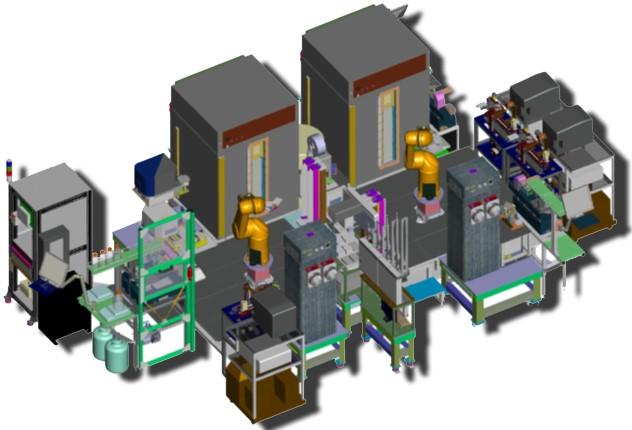Creating an automated high-throughput flow cytometry system

This is a computer aided design (CAD) of the screening system. Credit: Genomics Institute of the Novartis Research Foundation (GNF)
Flow cytometry is a very powerful tool that has been used for decades and allows for multiparametric readouts at the single cell level within heterogeneous cell populations. However, in the context of high-throughput screening, flow cytometry is slow, low-throughput, and is not amenable to automation.
The GNF group has developed a fully automated screening system that solves this problem. The system can achieve a throughput of 50,000 wells per day, resulting in a fully automated platform that enables robust phenotypic drug discovery.
Over the past five years, this screening system has been used for a variety of drug discovery programs, across many disease areas, with many molecules advancing quickly into preclinical development and into the clinic.
Pharmaceutical companies are tasked with finding new drugs that provide real benefit to patients. A common approach is through the use of phenotypic screening. This is dependent upon the ability to establish complex, biologically relevant screening assays and run high-throughput screening campaigns. However, this kind of complex biology requires new methodologies for lead identification and screening systems like the one developed by the GNF team.
###
A Fully Automated High-Throughput Flow Cytometry Screening System Enabling Phenotypic Drug Discovery can be accessed for free at http://journals.
A PDF of this article is available to credentialed media outlets upon request. Contact nhallock@slas.org.
About our Society and Journals
SLAS (Society for Laboratory Automation and Screening) is an international community of nearly 20,000 professionals and students dedicated to life sciences discovery and technology. The SLAS mission is to bring together researchers in academia, industry and government to advance life sciences discovery and technology via education, knowledge exchange and global community building.
SLAS DISCOVERY: 2016 Impact Factor 2.444. Editor-in-Chief Robert M. Campbell, Ph.D., Eli Lilly and Company, Indianapolis, IN (USA). SLAS Discovery (Advancing Life Sciences R&D) was previously published (1996-2016) as the Journal of Biomolecular Screening (JBS).
SLAS TECHNOLOGY: 2016 Impact Factor 2.850. Editor-in-Chief Edward Kai-Hua Chow, Ph.D., National University of Singapore (Singapore). SLAS Technology (Translating Life Sciences Innovation) was previously published (1996-2016) as the Journal of Laboratory Automation (JALA).
Follow SLAS on Twitter at @SLAS_Org.
Follow SLAS on Facebook at SocietyforLaboratoryAutomationandScreening.
Follow SLAS on YouTube at SLASvideo.
Follow SLAS Americas on LinkedIn at Society for Laboratory Automation and Screening (SLAS Americas).
Follow SLAS Europe on LinkedIn at Society for Laboratory Automation and Screening Europe (SLAS Europe).
Media Contact
More Information:
http://dx.doi.org/10.1177/2472555218773086All latest news from the category: Health and Medicine
This subject area encompasses research and studies in the field of human medicine.
Among the wide-ranging list of topics covered here are anesthesiology, anatomy, surgery, human genetics, hygiene and environmental medicine, internal medicine, neurology, pharmacology, physiology, urology and dental medicine.
Newest articles

NASA: Mystery of life’s handedness deepens
The mystery of why life uses molecules with specific orientations has deepened with a NASA-funded discovery that RNA — a key molecule thought to have potentially held the instructions for…

What are the effects of historic lithium mining on water quality?
Study reveals low levels of common contaminants but high levels of other elements in waters associated with an abandoned lithium mine. Lithium ore and mining waste from a historic lithium…

Quantum-inspired design boosts efficiency of heat-to-electricity conversion
Rice engineers take unconventional route to improving thermophotovoltaic systems. Researchers at Rice University have found a new way to improve a key element of thermophotovoltaic (TPV) systems, which convert heat…



